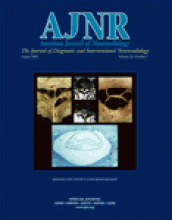Abstract
BACKGROUND AND PURPOSE: Several approaches to the treatment of dissecting aneurysms of the vertebrobasilar system have been used. We evaluated our endovascular experience, which includes trapping and proximal occlusion.
METHODS: Thirty-five patients with intradural vertebrobasilar dissecting aneurysms presented to our institution between 1992 and 2002. Twenty-six were treated by endovascular means and two with surgery. In the endovascular group, 14 were in a supra-posterior inferior cerebellar artery (PICA) location, and three of these extended to the vertebrobasilar junction on the initial angiogram. Ten were located in an infra-PICA location, or no antegrade flow was seen in the PICA or anterior spinal artery. Two were located at the PICA with antegrade flow preserved in the branch. Twelve lesions were treated with trapping; another 14 were initially treated with proximal occlusion techniques, two of which eventually required trapping procedures. Follow-up images were obtained within 1 year of initial treatment in 24 patients. Mean follow-up for these patients was 3.5 years.
RESULTS: Initial treatments were technically successful and without complication in all 26 patients. Follow-up examinations showed complete cure in 19 of 24 patients. One patient died of global ischemia after presenting as Hunt and Hess grade 5 with subarachanoid hemorrhage. Two recurrent hemorrhages occurred in patients in the proximal occlusion group; one died, and the other underwent a trapping procedure. One patient developed contralateral vertebral dissection 24 hours after occlusion of a dissecting aneurysm of the dominant vertebral artery and died of a brain stem infarct. Another died of probable vasospasm, and the last died of an unknown cause 1 month after treatment. Two patients had recanalization despite an initial trapping procedure, both underwent further treatment. Mortality rate was 20% in the treated group (including the two patients treated surgically), with four of five deaths occurring during the initial hospital course. Mortality rate was 50% in the six patients in the untreated group who were available for follow-up.
CONCLUSION: Dissecting aneurysms of the vertebrobasilar system remain high-risk lesions because of their natural history. They can be managed by endovascular methods according to aneurysm location, configuration, collateral circulation, and time of presentation. Trapping results in better prevention of rehemorrhage. Proximal occlusion can achieve occlusion without manipulation of the affected segment when more direct endovascular occlusion or stent placement cannot be performed.
- Copyright © American Society of Neuroradiology












